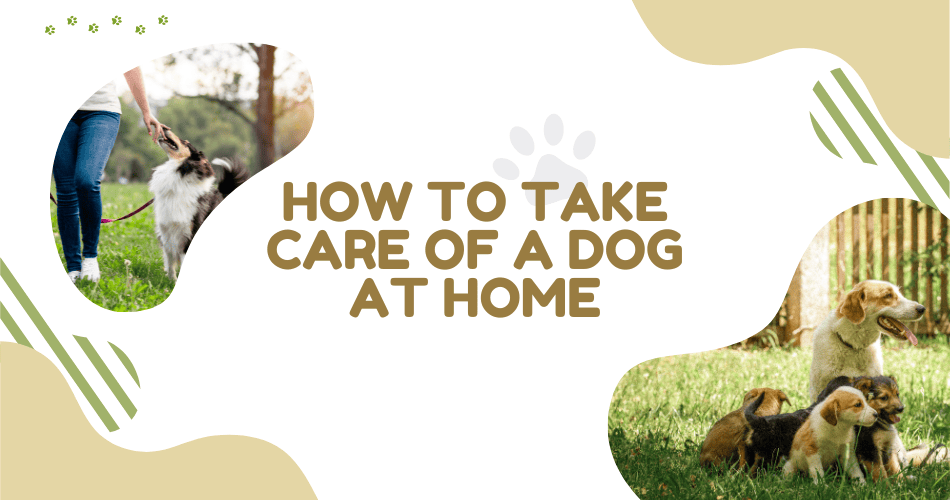Taking care of your dog isn’t laborious if you love your dog. But sometimes it can make you feel muddled. If you are a beginner and considering adopting a dog, you must know how to take care of a dog at home. To make a deep bonding with your pet, you will have to provide all the required physical and emotional needs.
One thing that we all know is pets give us unconditional love and they are like children to us. The way they amuse us, and befriended us is something that lacks in humans once in a while. So, as a pet parent, it should be one of the most important tasks in our day-to-day life to take care of our furry friend as much as we can.
The first step of caring is to make sure you know all the procedures to take care, nurture, and groom your beloved dog. So, if you are not a pro of dog care, or you are thinking about adopting a dog, then you’re in the right place. In this article, we will describe how to take care of a dog at home.
Ensuring Your Dog’s Fundamental Requirements Are Met
Three things are fundamental needs of every living soul on this planet. These are quality food, security and safety, and better health. So, if you own a dog, it’s good for you to ensure these core needs are met. When these fundamental requirements are met, your dog will grow stronger, happier, and healthier.
Naturally, a happy dog will bring joy and happiness to you, and your family and friends. Here, we will narrate how ensuring these needs lead your bonny dog to a better life.
High-Quality Food for Your Dog
Ensuring that your pets receive the proper nutrition they need is crucial, just like us humans. That’s why it’s important to give them food that meets their specific dietary needs. For example, dog food is specifically formulated to meet a dog’s nutritional needs, while cat food is tailored to meet the needs of our feline friends. It’s important to note that their nutritional requirements are vastly different from each other.
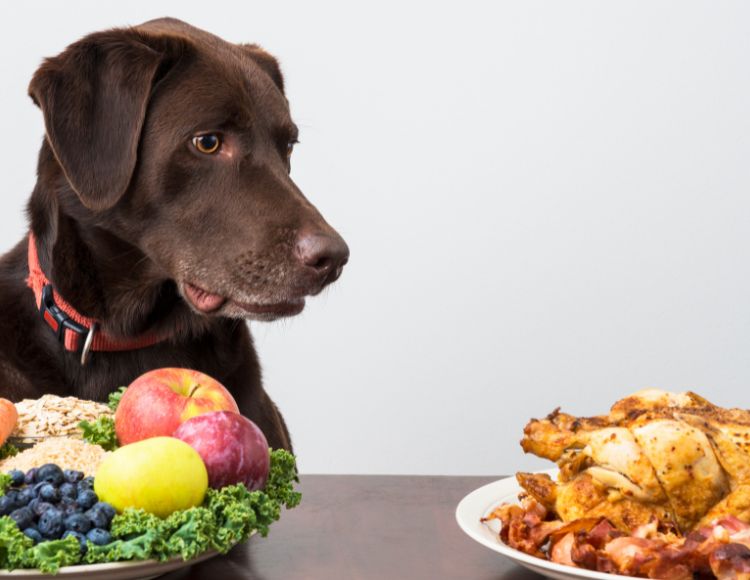
It’s worth mentioning that puppies and senior dogs have different nutritional needs, and pets with health issues may require special diets to address their unique needs. While table scraps might seem like a good idea to treat our pets, it’s generally not recommended since many of the foods we eat could be harmful to their health. Foods containing salt, garlic, and onions, for instance, can cause illnesses and even prove fatal to our furry friends.
It’s also essential to feed our pets in the right quantities. Overfeeding them or giving them too many treats could lead to obesity, which could, in turn, cause more health problems such as heart disease and renal problems. As a responsible pet owner, you need to weigh your options when it comes to pet food to avoid such illnesses.
Here is a list of things to consider while choosing quality food for your dog:
- Choosing the Appropriate Dog Food: You should look for dog foods that use high-quality protein sources, such as chicken, fish, or lamb. It’s better to avoid foods that contain fillers or artificial preservatives. You must choose a dog food that is appropriate for your dog’s age, breed, and activity level.
- Read the labels: Always read the labels on dog food packages carefully. You should search for dog foods that have a named source of protein (e.g., “chicken” instead of “poultry”) listed as the first ingredient. You should intend to avoid foods that contain by-products, as these can be lower-quality parts of the animal.
- Consider a balanced diet: Your adorable dog needs a balanced diet that includes protein, carbohydrates, and fats, as well as vitamins and minerals. Consult with your veterinarian to determine the appropriate balance of nutrients.
- Provide Enough Water: Your dog might not be always thirsty. But try to give them a fresh water bowl along with their regular food. You can also add some ice cubes if it is hot outside. It will help them keep hydrated.
- Avoid table scraps and human food: It is tempting to share your food with your dog, but it’s not the best idea and it’s better if you avoid feeding them table scraps or human food. These foods can be high in fat, salt, and sugar and can lead to obesity and other health issues.
- Keep your dog’s weight in check: You should feed an appropriate amount of food to your dog. The amount can vary based on its size, breed, and activity level. It is also important to maintain a healthy weight. Obesity can lead to a variety of health problems in dogs, including joint problems and diabetes.
- Consider supplements: In some cases, your veterinarian can recommend supplements such as omega-3 fatty acids or joint supplements to keep up the good health of your furry friend.
Ensuring a Secure Environment for Your Dog’s Safety
If you want to take care of your new dog or newborn puppy, you might not know all those staffs at your home that can harm your loveable dog. Since you’re a beginner, you should consider making your home safe and secure for your furry friend. Poisonous plants in the garden, high buildings, and garden chemicals can cause serious illness to your dog.
In this section, we have compiled a list of what is needed to take under consideration to make your home safe.
- Hazards in the Home: If you’re living in a high building, then you must prevent your dog from going to the balcony, or unprotected area from where he/she can fall. Besides, garden chemicals like Disulfoton pesticides (Organophosphate), found in rose-protecting products, are regarded as highly toxic to dogs. It can trigger serious illnesses like diarrhea, vomiting, seizures, and sometimes death. If you have a garden, make sure to keep it away from your dog. It is true that there are some fruits and vegetables dogs can eat, but there are plants like Castor bean, Dumbcane, Oleander, and some other plants that are considered extremely poisonous to dogs, revealed by ASPCA animal poison control. As dogs are inquisitive animals, it is not recommended to explore your home and yards unattended.
- Home Environment: Your dog must keep in a safe, comfortable, and clean place, where it can take rest and roam around without any risks. Its place should be dry and draught-free since a humid place can lead to infections and diseases. Besides, an overheated area is also not suitable for your dogs, as dogs are vulnerable to heat stress.
Signs of Heat Stress:
- fast heart rate
- Inflated panting
- Extreme drooling
- vomiting
- dizziness and confusion
- shaking
- seizures
Maintaining Good Hygiene And Health
To maintain good health and hygiene, both for your furry friend and human, you need to check regularly whether the living place is clean or not. From changing the litterbox to cleaning the food bowl, you must do everything you can, to make sure you have a safe, clean, and germ-free living space. Here are some points to remember to maintain good hygiene for your dog.
- Tips for Bathing Your Dog: Bathing your dog is important and it is recommended to use shampoos that are specifically designed for dogs. Besides, brushing your dog before a bath can help remove tangles and mats. However, you should use lukewarm water and rinse thoroughly.
- Keeping Your House Clean: Your loveable dog can also bring dirt and germs into your home. So, you should clean your home to prevent bacteria and other diseases. Besides, most dogs including German Shepherds shed a lot of hair, so you must vacuum your floor and furniture on a regular basis.
Establishing Consistent House Training and Walking Routines
If you want to own a dog, you must be ready to schedule a training session and walking routine for your dog. Without investing an adequate amount of time in your dog’s growth, it isn’t possible to train him/her. You can follow the following tips for consistent training and walking routines.
Establishing consistent house training and walking routines is essential for your dog’s health and well-being, as well as for maintaining a clean and happy home. Here are some tips to help you create a consistent routine for your dog:
- Set a Schedule: Consistent schedule is essential for house training and walking routines. Decide on specific times of the day when you will take your dog outside for a walk or to use the bathroom. It will assist them to comprehend what is expected of them.
- Use Positive Reinforcement: You can use positive reinforcement techniques to encourage good behavior in your dog. When your dog follows your command, reward him/her with praise, treats, or a favorite toy.
- Be Patient: House training and walking routines can take time to establish. You must be very patient with your dog. Consistency is key here. Always stick to your routine.
- Use a Crate: If you’re house training a puppy or a new dog, you can use a crate as an effective way to establish a routine
- Keep It Positive: Maintaining a positive attitude towards your dog’s training is important. In this case, you need to avoid punishment or negative reinforcement since this can trigger anxiety or fear. Instead of it, you should focus on positive reinforcement and be patient.
Keeping Your Dog Mentally and Physically Active
As pet owners, we all want our dogs to be happy and healthy. Though some dog breeds can be left alone, most of the dogs need a companion. To achieve this, we need to keep our furry partner mentally stimulated. This stimulation helps to prevent boredom and can reduce the risk of a dog’s behavioral problems such as anxiety and depression. Here are the tips for a dog parent to implement:
1. Regular Exercise Routine
Regular exercise is important to keep your dog mentally stimulated. Daily walks, runs or hikes can help to prevent boredom. It also promotes a healthy lifestyle. Regular Exercise releases endorphins. It can help to reduce stress and anxiety.
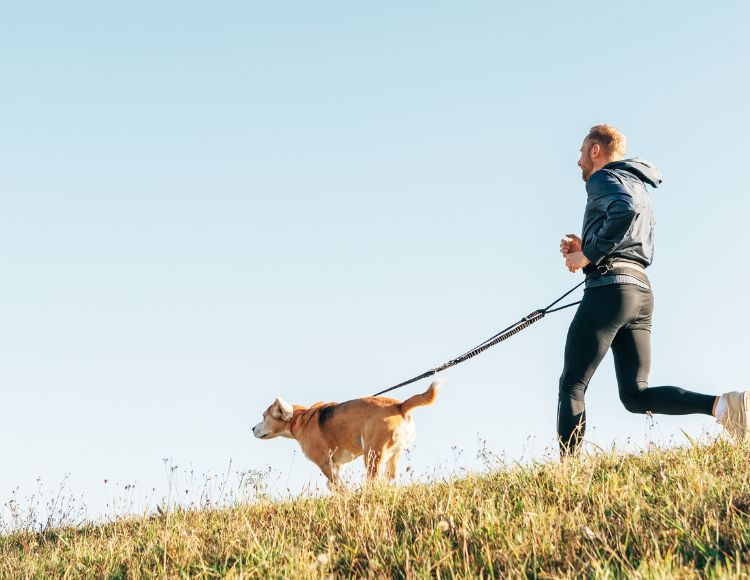
2. Teaching Your Dog New Tricks
Does your dog know any tricks? Do you know that teaching new tricks to your dog can mentally stimulate him/her? Yes, if you teach your dog new tricks or commands, it can help to boost its confidence. Besides, it can assist a timid and fearful dog to convert into a playful one.
3. Agility Training
Agility training is a competitive activity that entails maneuvering through an obstacle course. It can also help to improve their coordination and problem-solving skills.
4. Playing Fetch and Other Active Games
Games or activities like hide-and-seek games, scent work, and sensory walks are designed to stimulate your dog’s senses and provide mental stimulation.
5. Interactive Toys
Interactive toys are a great way to keep your dog mentally stimulated. Puzzle toys, for example, require your dog to solve a problem to access a treat. This also assists in thwarting destructive behavior.
6. Obedience Training
Obedience training is beneficial for teaching your dog basic commands. It can also provide mental stimulation. Training sessions challenge your dog to learn new behaviors. It also assists them to learn problem-solving skills.
7. Nose Work
Dogs have an incredible sense of smell. Nose work is a great way to tap into this natural ability. You can start by hiding treats around your home and encouraging your dog to find them. This can be a fun and challenging game for your dog.
8. Socialization
Socialization is important for dogs to develop their social skills. It also prevents anxiety and aggression. Regular trips to the dog park or playdates with other dogs can help with mental stimulation.
9. Food-Dispensing Toys
Food dispensing toys are another way to keep your dog mentally stimulated. These toys require your dog to work for their food, providing a challenge and mental stimulation.
10. Grooming Your Dog
If you want your dog to be clean and shiny, regular grooming is crucial. Regular bathing, trimming nails, cleaning ears, brushing teeth, and checking your dog’s skin are so far the best-required actions of grooming.
However, you may take help from a professional groomer, who is able to cut and style a dog’s hair, can trim nails, and often, sell grooming products such as medicated shampoos or dog lotions. Here we will talk about how you can groom your dog in the comfort of your own home.
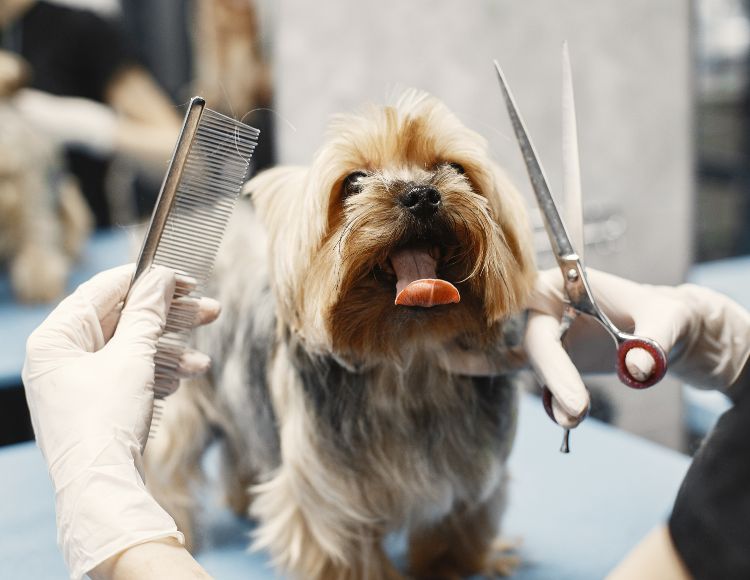
11. Trimming Nails
Trimming your dog’s nails can be challenging, but with the help of the right tools and technique, you can keep your furry friend’s paws looking and feeling healthy. It’s important to ensure your dog is calm and relaxed before you begin trimming. You should use a pair of dog nail clippers that are the right size for your dog’s nails.
Locating the quick is crucial since it contains blood vessels and nerves. You must avoid cutting it as it can be painful and cause bleeding. If your dog has dark nails, it can be more challenging to spot the quick, and you’ll need to take extra care.
You should start by snipping off just the tip of the nail and work slowly to avoid cutting the quickly. If your dog’s nails are long, or broken, it may take several sessions to trim them safely. It’s essential to take breaks and give your dog some praise or a treat to keep them calm during the process.
If you accidentally cut the quick and your dog starts bleeding, you can apply some styptic powder to the nail to stop the bleeding. If you’re not comfortable trimming your dog’s nails, you can always take them to a professional groomer or vet for help. With patience and practice, you’ll soon be able to keep your pup’s nails in excellent condition. If you’re still wondering how to trim your dog’s nails safely, you can follow this step-by-step guide.
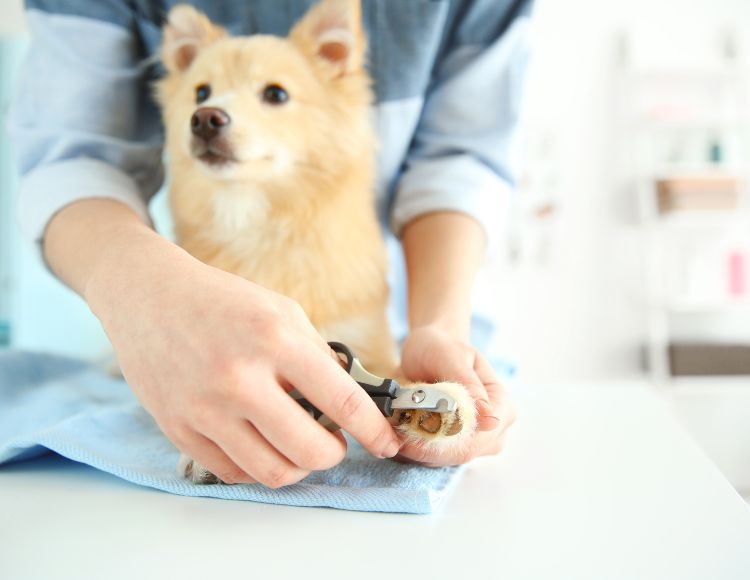
12. Cleaning Your Dog’s Ears at Home
If you’re a beginner as a dog parent, you might have to face some challenges while cleaning a dog’s ear at home. So, it’s a good idea to read and learn all the processes to do it. Here we covered how to do it properly.
Get ear cleaning solution and cotton balls or gauze pads. You can buy ear-cleaning solutions from your vet or a pet store. Don’t use household cleaning products, as they can be harmful to your dog. Make sure, your dog sits or lies down in a cozy place.
Check your dog’s ears for any signs of redness, swelling, discharge, or an unpleasant odor. If you see any of these, talk to your vet. Apply the ear-cleaning solution as directed on the bottle. Gently pour it into your dog’s ear canal, being careful not to insert the tip of the bottle too deeply.
Massage the base of your dog’s ear for about 30 seconds to help the solution work its way down into the ear canal. Use a cotton ball or gauze pad to gently wipe the inside of your dog’s ear. Don’t push any debris further down into the ear canal. You may need several cotton balls or pads to clean the ear.
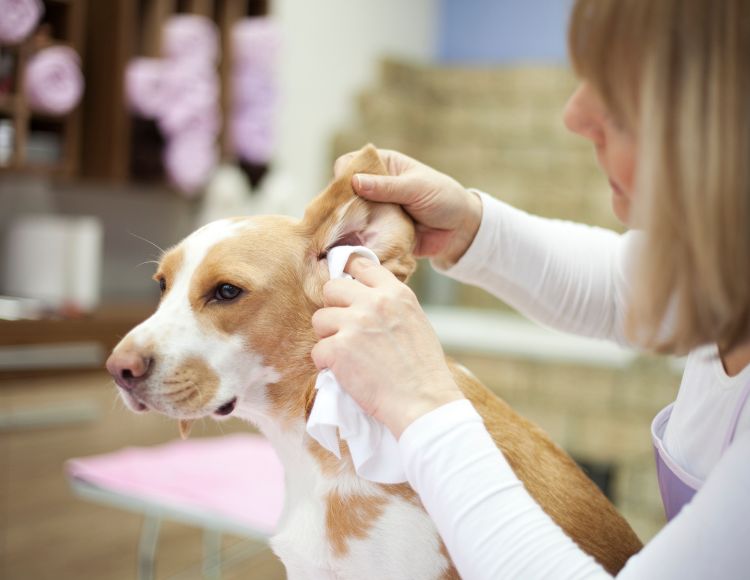
If you have any concerns about your dog’s ears or how to clean them, talk to your vet. You can also read a more detailed step-by-step guide on cleaning your dog’s ears at home published by American Kennel Club.
13. Brushing Teeth
We, humans, brush our teeth every day. Do dogs need it too? The answer is yes. The vet recommends brushing at least three times a week for dogs. It helps to take off plaque and prevent tartar. It will sound great if you hear that dogs can really enjoy brushing if you do it to them regularly.
To brush your dog’s teeth, you need to gather all your tools including a soft toothbrush, and dog-friendly toothpaste. To test the toothpaste, put it on your fingertip and give it to your dog to lick a little bit. If they refuse to take it, change the flavor.
Choose brushing time while your dog is not agitated. Do not try to do it forcefully. If it becomes upset, stop it and try to do it later. Veterinarians advocate using the toothbrush in the downward direction. Always make sure you respond to your dog’s natural reaction while brushing.
14. Things to Check While Grooming Your Dog
Checking your dog’s skin is an essential part of grooming that can help you assess your dog’s overall health. While grooming check for lumps and bumps that could be a sign of a benign or cancerous tumor. Always consult with your vet if you find any suspicious growth.
Watch out for fleas and ticks, especially during warmer months. Check your dog’s ears, toes, tail, groin, eyes, and collar for any parasites. Also, look for signs of flea infestation, such as black specks in your dog’s fur.
Look for cuts, scrapes, or scabs, especially on your dog’s paws and legs. Treat them before they get infected. Check for signs of pain during grooming, which could be an indication of arthritis, inflammation, or other conditions. Consult with your vet if you notice any signs of discomfort.
Pay attention to any unusual odor emanating from your dog, which could indicate skin, oral, or ear problems. You should remove mats and tangles in your dog’s fur, which can be uncomfortable and unhealthy for your dog. Always check for dry skin, which could be a symptom of allergies, parasites, hot spots, stress, or excessive bathing.
Last but not least, Don’t forget to inspect your dog’s teeth and mouth for signs of bacteria, plaque, tartar, gingivitis, receding gums, and tooth loss.
Ensuring Your Dog Always Has Access to Fresh Drinking Water
We assume you’re a beginner, and you want the best care for your dog. If so, you need to keep an eye on your dog whether he/she is hydrated or not. Ensuring fresh water for your dog is obligatory. If your dog reveals symptoms like tiredness, loss of appetite, sunken eyes, and moving more slowly than normal, then dehydration might be the cause of these. So always make sure your furry friend is getting enough fresh and clean every day.
Spending Quality Time with Your Dog
If you own a dog or any type of pet, two things you’ll have to make sure of, are its physical and mental health. To do these effectively, you must spend quality time with your dog which will eventually create deep bonding between you and your loveable dog.
For instance, you can take your dog to shopping or sea beach and let it explore the outside world. If there is any pet club in your vicinity, you can take your dog there to get socialize. Furthermore, dogs are inquisitive, they love would love new sights and landscapes, so you can also pay a visit to the countryside with your dog which can be really thrilling.
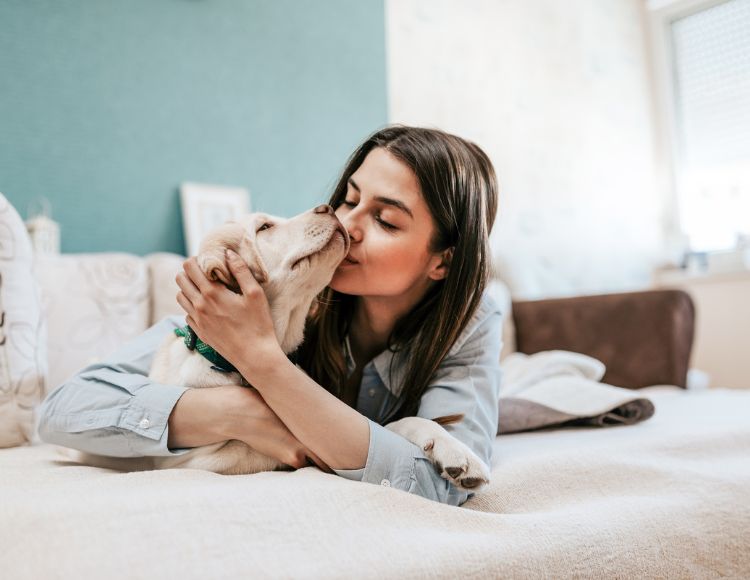
In Short
As a newly-minted canine caregiver, it’s an obligatory task to meet the basic needs of your furry companion. This means guaranteeing access to ample supplies of high-quality food and fresh water. Investing time in bonding activities will also play a key role in fostering content and a calm manner in your beloved pet. Moreover, training exercises, outdoor strolls, and engaging interactions are essential for keeping your pooch mentally stimulated. Above all, tending to your dog’s well-being at home is easy, especially if you’re devoted to a life of harmonious coexistence with your four-legged friend.

